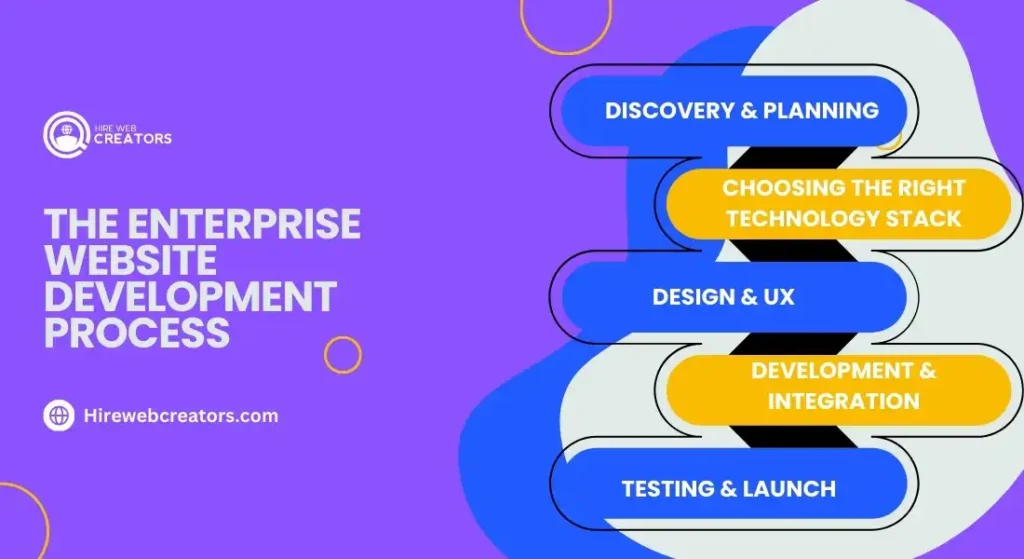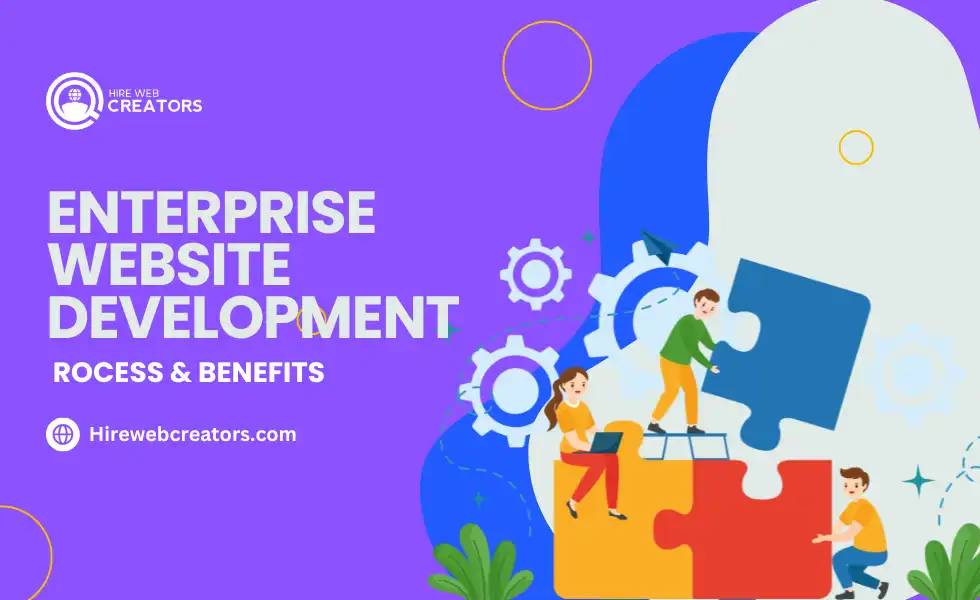Enterprise website development made easy! Discover benefits, expert tips, and best practices to build a scalable high-performance site. In the digital age, enterprise website development has become one of the most crucial reasons for success, giving simple design the additional blessing of the ability to shape brand perception and customer experience. A powerful enterprise website isn’t just a digital asset—it’s a strategic tool for scaling and growth.
However, many enterprises still face issues like:
- Outdated design and slow loading times
- Poor user experience and navigation
- Inability to scale with growing business needs
A comprehensive guide on how to tackle these challenges-from full development, outlining the benefits of core-yields best practices that can help your enterprise website perform at its best.
Table of Contents
What is Enterprise Website Development?
Enterprise website development is about building huge, highly customized sites to properly express the complex needs of medium-sized and large enterprises. Unlike regular websites, enterprise sites are designed to handle high traffic, integrate with many internal applications, or realize intricate functionalities that fulfill different user needs.

Importance:
Enterprise websites stand apart from small business sites due to their focus on:
- Scalability: Built to manage vast amounts of content, traffic, and user data without compromising performance.
- Security: Implementing top-tier security measures to protect sensitive company data, client information, and transactions.
- Complex Integrations: Seamlessly connecting with CRM systems, e-commerce platforms, ERP solutions, and other third-party applications.
Examples:
- Microsoft: A dynamic and feature-rich site showcasing product information, resources, and services for a global audience.
- IBM: An enterprise site offering tailored solutions, industry insights, and integrated customer support tools.
- Salesforce: Provides extensive resources, integrations, and a powerful user portal, illustrating the capability of enterprise-level web design.
The Enterprise Website Development Process

Step 1: Discovery & Planning
Every successful business enterprise website project starts with a strong understanding of the business goals and requirements of the users. Determination of the target audience and a clear definition of the website’s purpose are required at this stage. Proper planning includes the scope determination of the project and its realistic timelines followed by gathering all the requirements as deemed necessary; hence, the stakeholder’s goals will be aligned, and there will be exact definitions of the entire development process.
Step 2: Choosing the Right Technology Stack
A scalable and high-performance enterprise website will be built with the appropriate technology stack. Many times, a clear understanding of project goals and integration needs is required for choosing a proper content management system, frameworks, or back-end technologies. Options include WordPress VIP for enterprise-grade features, Drupal for extensive customization, or React for dynamic front-end performance. There is also a very flexible headless CMS that can be paired with Next.js for speedy load times and smooth delivery of the content.
Step 3: Design & User Experience (UX)
Making an enterprise website both aesthetically pleasing and functionally sound mostly depends on design and user experience. A user-centric design should complement the brand’s character, therefore improving the user journey utilizing a consistent layout and easy navigation. Good responsive design lets the site fit well across devices, from desktop computers to cellphones. Giving user experience optimization top priority via well chosen design features will greatly increase engagement and conversions.
Step 4: Development & Integration
While guaranteeing flawless interaction with current corporate software systems, the development phase emphasizes on building scalable, clean code. This could include connecting with enterprise resource planning (ERP) systems, customer relationship management (CRM) tools, or other outside programs. Connecting many tools and services requires APIs and bespoke integrations, which together provide a single ecosystem improving functionality and user experience.
Step 5: Testing & Quality Assurance
To guarantee the website runs perfectly before launch, thorough testing is necessary. Functional testing to ensure usability, speed and load capacity performance testing, and security testing to find possible weaknesses comprise this step. While hand testing provides a closer look at user interactions and site behavior, automation techniques like Selenium help simplify repeated tests. A polished, dependable product is delivered in part by thorough quality assurance.
Step 6: Launch & Deployment
Starting a corporate website calls for careful planning to guarantee a seamless rollout. Final testing, server configuration, backup building, and integration verification should all be on a pre-launch checklist. By addressing these components, you reduce the possibility of mistakes and guarantee a flawless user experience right from first. The deployment process should be managed cautiously, closely observing the site in the first hours following go-live.
Step 7: Post-Launch Support & Maintenance
The job does not stop at launch; the long-term success of an enterprise website depends on constant care and maintenance. Frequent updates, security fixes, and performance monitoring help to maintain the site in running order. Active support guarantees that the website responds to changing user needs and technology developments, therefore preserving its value as a strategic corporate asset.
Benefits of Enterprise Website Development

Scalability
Designed to handle vast amounts of data and traffic without sacrificing performance, enterprise websites are structured to reflect expected expansion. The architecture of the website may easily grow with the size of your company to provide a flawless user experience even in cases of heavy traffic. Businesses expecting seasonal peaks in visitation or steady increases depend on this scalability.
Enhanced Security
Given the sensitive data they usually manage, security is the first concern for business websites. SSL certificates, firewalls, and multi-factor authentication—advanced security tools—protect against possible threats. To protect client data as well as business, enterprise websites also include strong data encryption systems, frequent security assessments, and industry-standard compliance.
Integration Capabilities
One of the main benefits of developing an enterprise website is its simplicity in interacting with current corporate systems. Enterprise websites can interact with CRM like Salesforce, ERP systems like SAP, or marketing automation tool HubSpot to simplify processes and offer a consistent user experience. This degree of connection lets companies simplify processes and concentrate data.
Improved User Experience
User experience (UX) is a priority on a well-designed corporate website to keep visitors interested and happy. Enterprise websites make visitors’ trips smooth using responsive design, fast load speeds, and easy navigation. These websites can immediately help to raise user retention and conversion rates by providing a flawless and fun browsing experience, therefore supporting the expansion of businesses.
SEO and Visibility
The development of an enterprise website gives technical SEO and content optimization a great priority to improve search engine result visibility. Improved search results come from speed optimization, neat code, and mobile responsiveness. Furthermore, a thorough content strategy in line with the search intent helps generate natural traffic, therefore increasing the discoverability of the website to possible users.
Including these advantages, corporate websites are great tools that not only help with company objectives but also strengthen client confidence and brand recognition.
Best Practices for Enterprise Website Development
1. Prioritize Mobile-First Design
Using a mobile-first design approach is crucial in a time when most web traffic originates from mobile devices. From desktop computers to cellphones, the responsive design guarantees that your company website offers a flawless experience on all devices. Giving mobile usability first priority helps you to satisfy today’s on-the-go consumers, lower bounce rates, and increase user engagement.
2. Focus on Speed Optimization
Directly affecting user experience and search engine results is page speed. Use a Content Distribution Network (CDN) to deliver materials more effectively, compress images without sacrificing quality, and take advantage of browser cache to best maximize load times. These techniques help to lower latency, thereby guaranteeing that your website loads fast even under heavy traffic.
3. Implement Robust Security Measures
Every level of the creation of the corporate website should incorporate security. Start with SSL certificates for encrypted data movement and install firewalls to stop illegal access. Identification and reduction of possible hazards depend on regular security audits and vulnerability assessments. Using multi-factor authentication increases the security of your website by adding still another degree of protection for private information.
4. Use Scalable Infrastructure
Enterprise websites should be developed on scalable infrastructure if we want to enable development and manage changing traffic. AWS, Google Cloud, and Microsoft Azure among other cloud hosting options give the ability to scale resources up or down depending on demand. For business-level websites, these systems also offer improved performance, redundancy, and built-in security elements.
5. Regular Updates and Maintenance
An enterprise website is not a one-time effort; it needs constant maintenance and updates to remain secure and run well. Security patches, plugins, and routine upgrades for the CMS all help to prevent weaknesses. Regular backups guarantee that, should a problem arise, data may be rapidly restored. Analytics and performance monitoring can offer information for ongoing development, thereby maintaining the website in line with corporate objectives.
Following these best practices can ensure long-term success and scalability as well as help you create a premium business website with outstanding performance, security, and user pleasure.
Expert Tips for Enterprise Website Development Success

Aligning the aims of the website with corporate goals depends on the early engagement of stakeholders in the project. Departmental inputs from marketing, IT, and sales guarantee a complete approach and help to create a site that satisfies several needs and improves user experience.
Making wise decisions calls for giving data analytics top priority. Using tools like Google Analytics, HubSpot, or Adobe Analytics—which provide insightful analysis of user behavior—you can better analyze performance, maximize content, and increase interaction.
Finally, long-term success depends on future scalability being planned for. Choose scalable infrastructure and flexible architecture to allow for expansion and new integrations—cloud hosting, for example This strategy guarantees that your enterprise website stays adaptable and helps you to avoid expensive updates as your company develops.
In Conclusion, the Development of a business website is, all things considered, a thorough process needing careful planning, the appropriate technological stack, user-centric design, and strong security measures. Following best practices and combining professional tactics can help companies create scalable, safe, and high-performance websites that propel expansion and provide a first-rate user experience. Giving every stage, from design and discovery to continuous maintenance, top priority guarantees a strong digital presence and long-term success.
Don’t hesitate to contact professional help if you’re ready to begin your corporate website project or require experienced direction. For your company, a well-run website may be revolutionary.
We really would want to hear from you. Comment below your ideas, questions, or observations; let’s carry on the discussion and support one another to create successful business websites.
Frequently Asked Questions (FAQs)
How long does enterprise website development take?
The timeline for enterprise website development varies based on the project’s complexity, but it typically takes 3 to 6 months. Larger projects with extensive custom features may require additional time for thorough testing and integration.
What’s the typical cost of an enterprise website?
The cost of an enterprise website can range from $50,000 to $500,000, depending on the scope, features, design, and technology stack. Factors like custom integrations, security requirements, and ongoing maintenance can also influence the final budget.
Which platform is best for enterprise websites?
Popular choices for enterprise websites include WordPress VIP, Drupal, and Adobe Experience Manager due to their scalability, flexibility, and extensive customization options. The right choice depends on your specific needs, budget, and integration requirements.
What is an enterprise website?
An enterprise website is a large-scale, complex site designed for medium to large businesses, focusing on scalability, security, and advanced integrations. It often serves as a key digital asset, supporting customer engagement, brand positioning, and business operations.
What are enterprise web services?
Enterprise web services refer to the backend services and APIs that connect an enterprise website with various business systems like CRM, ERP, and marketing automation platforms. They facilitate seamless data exchange and enhanced functionality.
What is enterprise process web?
Enterprise process web is a term used to describe the integrated workflow management capabilities of an enterprise website. It includes tools and processes that streamline business operations, automate tasks, and improve collaboration across different departments.










